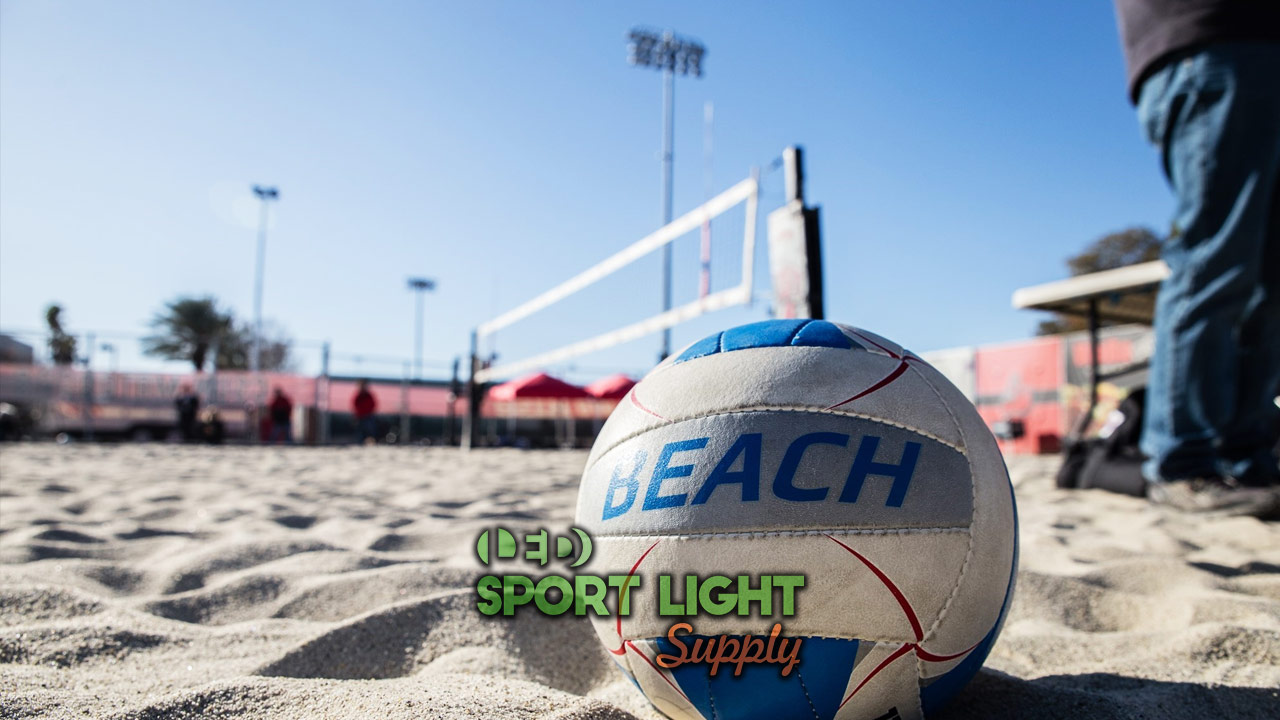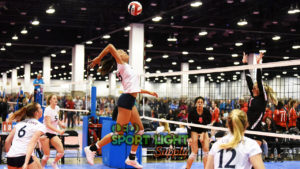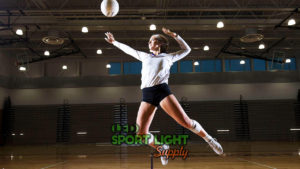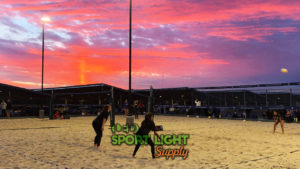Goals of beach volleyball court lighting
1. Optimize the use of the sand volleyball court at night
 Primarily, beach volleyball court lighting allows for playing matches until late at night. Mostly because it is more convenient for people to play sand volleyball at night.
Primarily, beach volleyball court lighting allows for playing matches until late at night. Mostly because it is more convenient for people to play sand volleyball at night.
Volleyball clubs can increase revenue streams by extending the use of their outdoor sand volleyball courts. Then again, LED floodlighting can provide cost-effective illuminance for indoor courts as well.
Beach volley is enjoyable at every hour of the day and night!
2. Improve the attackers’ vision
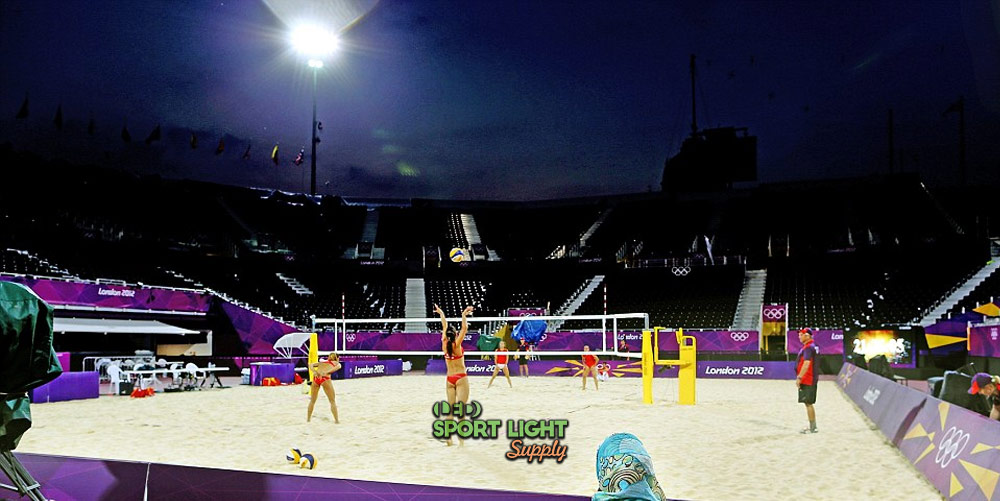 Going for a kill requires focus and commitment. But when the attacker jumps to hit the ball, illuminance and glare are crucial factors.
Going for a kill requires focus and commitment. But when the attacker jumps to hit the ball, illuminance and glare are crucial factors.
The right lighting layout can make the difference between a Vegas line and crushing it out of bounds. In fact, the lighting design takes care of technical aspects, such as:
- the suitable light level
- uniform light distribution
- glare-free light sources
- vertical angles
Indoor and outdoor lighting systems keep the players at the center of everything. They are an integral part of the whole sports experience. From the sand to the volleyball net, each detail must be structured to help players give their best on the volleyball court. And lights are no different.
3. Create an atmosphere for spectators
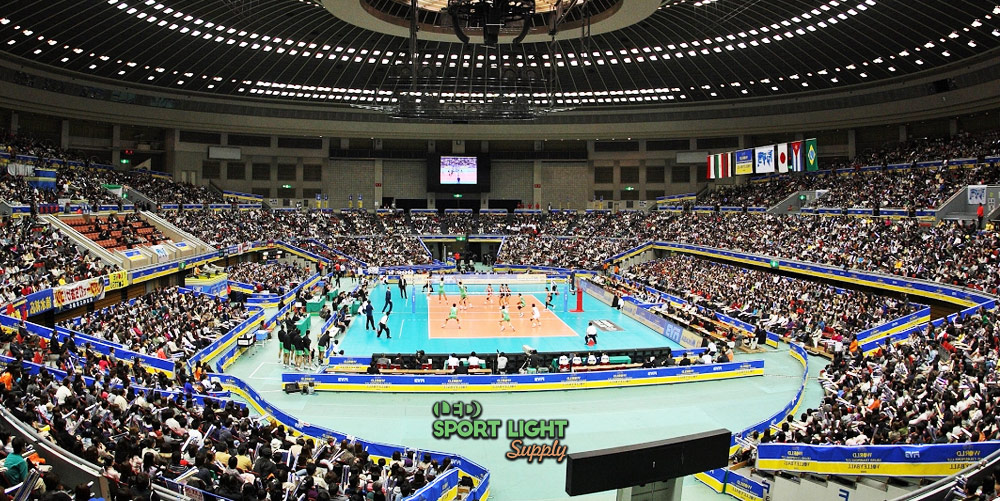
On the other side of the telly, or cheering in the stands, spectators gather to enjoy their beloved sport. But no sport would be as successful without the proper lighting design and layout.
Illuminance does not only serve to enhance the players’ performances. In fact, most of the technical data on the lamp spec sheets have the bystanders in mind. Here are some examples of what I mean:
- CRI helps you choose lights that render realistic colors
- Flicker-free lights let you enjoy perfect televised broadcasts
- The IP rating ensures lighting during brief showers of rain
A well-designed volleyball court lighting layout lets fans savor each point. Especially the most intense match points.
4. Ads placement
From the management point of view, the sand volleyball court is an asset. As such, the more attractive the venue, the better the sponsors. That is, the profits from their ads.
When it comes to national/international tournaments such as AVP, this means that owners can add more sponsorship ads on their sand volleyball court.
Sponsors evaluate each sports arena from a different perspective. In fact, the sponsors’ goal is to place their messages and products. So, better lighting means exposure. But not only that, the more prestigious the level of competition, the most likely the positive associations with their brand/service/etc.
Best lighting for outdoor beach volleyball courts
1. Flood lights
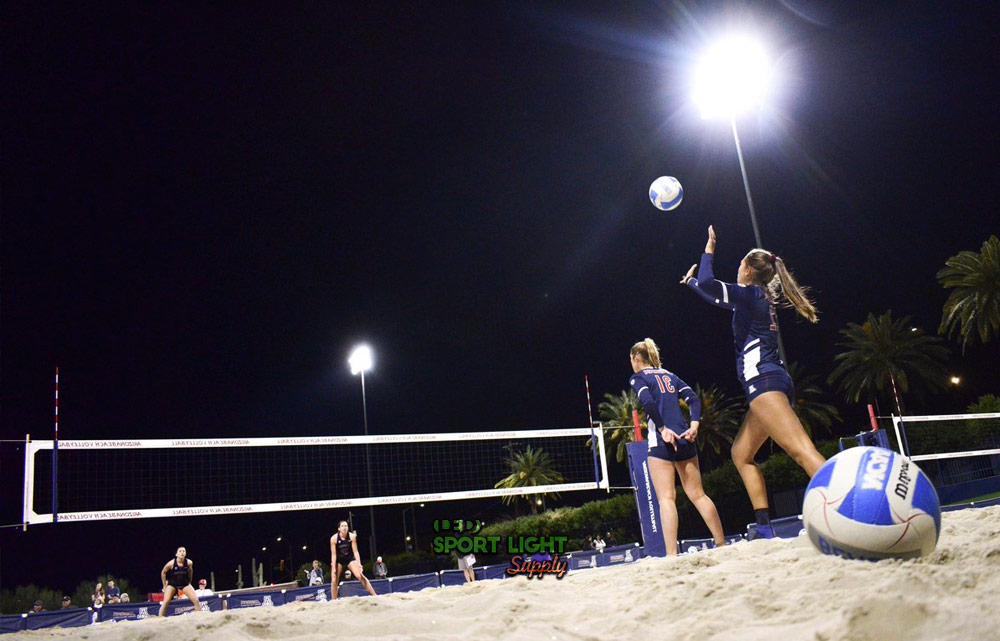
High mast floodlighting is the best lighting solution to illuminate an outdoor sand volleyball court. The alternation of the rally and sideout scoring systems can drag a match out for hours. So, it is not unusual for beach volley matches to end late.
Today’s flood lights are made of a standard LED projector and a lamp holder. Usually, their casings are dust- and water-proof because most sand volleyball courts are set on a beach.
2. Portable light towers
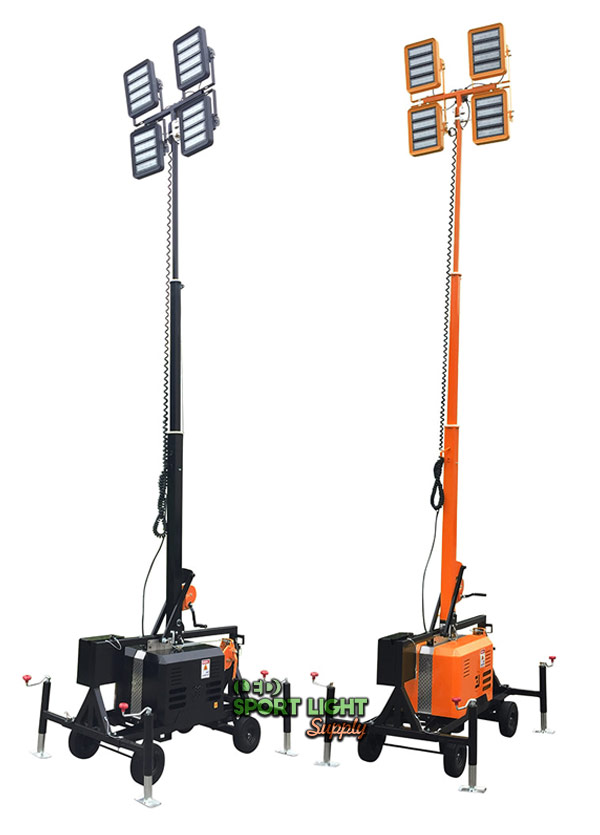 A portable light tower is a temporary lighting solution. Among the various models, the one with solar lighting is a good choice. Mostly because this model comes with a photovoltaic panel and a battery. In other words, it is an independent lighting system that lets you save running costs.
A portable light tower is a temporary lighting solution. Among the various models, the one with solar lighting is a good choice. Mostly because this model comes with a photovoltaic panel and a battery. In other words, it is an independent lighting system that lets you save running costs.
A movable light tower can be placed virtually anywhere. For example, near the sidelines or on a dedicated platform. Here are some features that make portable lights unique:
- telescopic lamp post
- generator
- solar panels
- trailer
- wheels
- safety chains
What lights are used in indoor sand volleyball court?
1. High bay lights
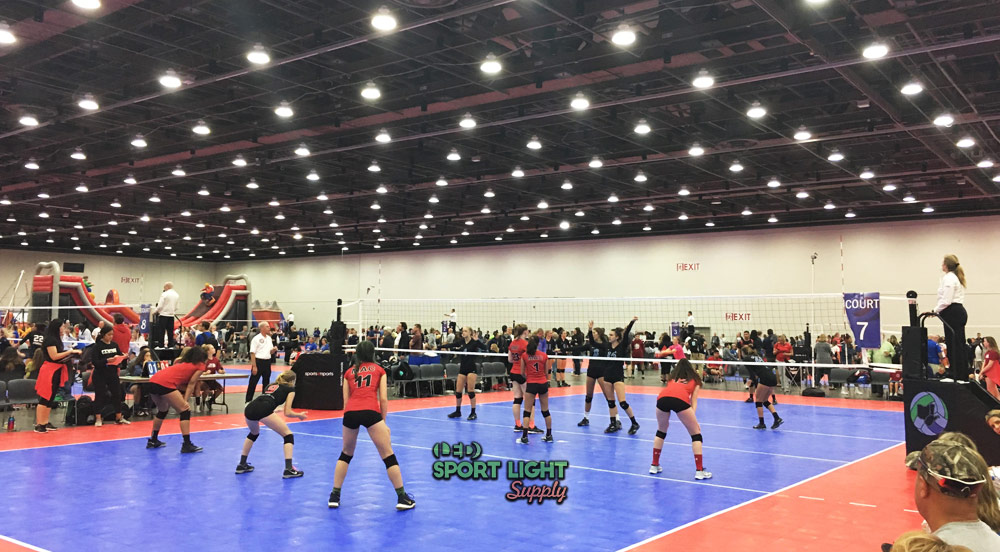
Most high bay fittings come with LED light sources and can fit any indoor venue. Unlike low bay lights, high bay lights have lens angles for high ceilings. That is, any indoor arena higher than 20 feet (6 meters). For this reason, they do not hang as low as from the frame, bracket, or upper limit. The changes of a high free ball hitting them are thus reduced to the minimum.
2. Linear lights
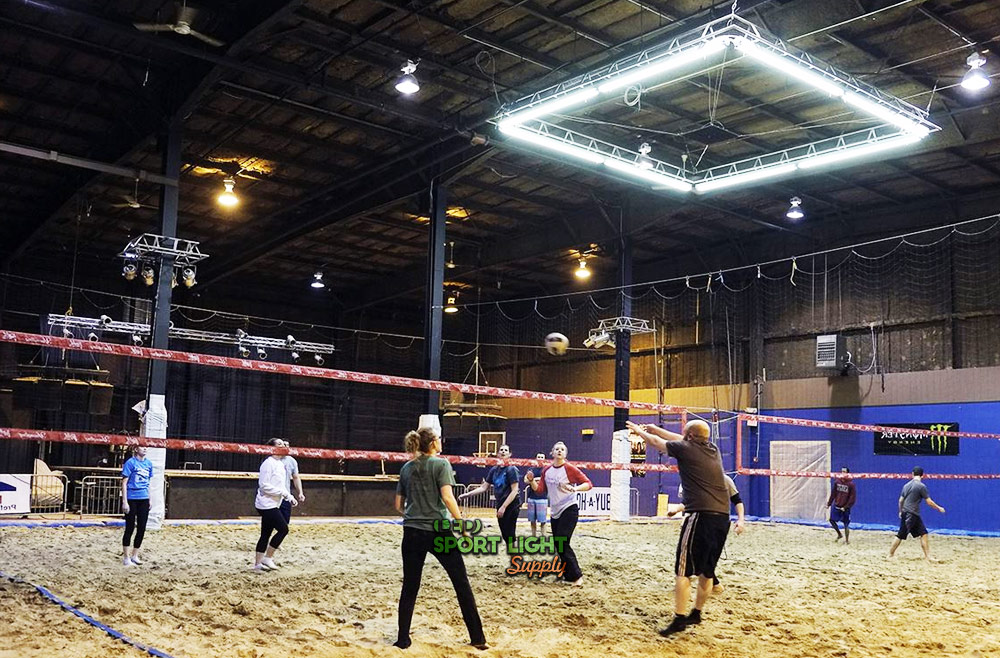
Designing the lighting system allows for creative works that can enhance the volleyball court and the stands. And to do that, LED linear lights are the ideal solution. They create unique lighting patterns. Plus, they are space-saving.
A balanced combination of linear lights and high bay lights can turn the average court into a mesmerizing scene of action. Then, during timeouts and team side switches, they add glamour to the venue, igniting the arena. Above all, they prove to be a cost-effective way to give televised events the perfect volleyball match scenario.
Outdoor beach volleyball court lighting design
1. Lux and footcandle level required
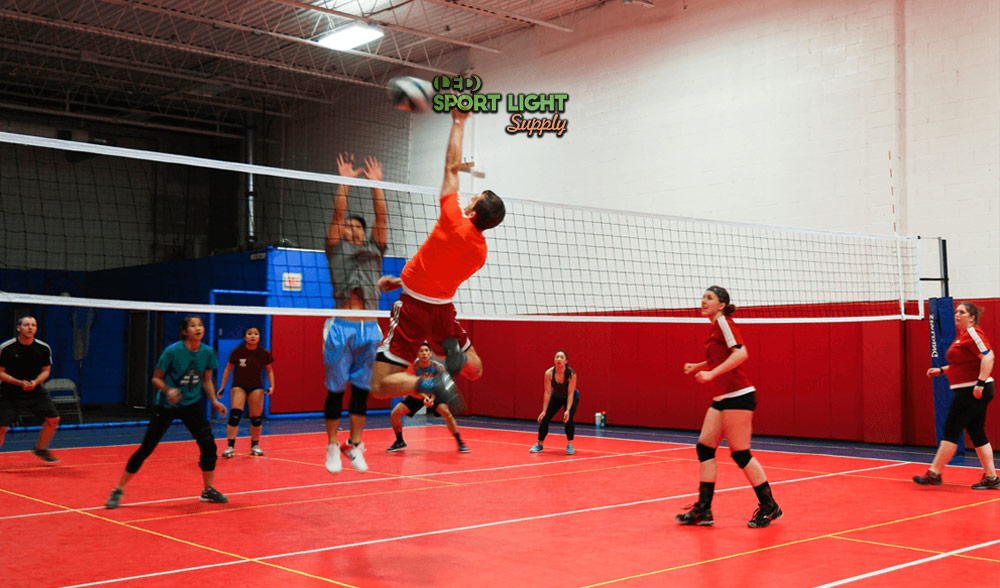
Beach volley is better enjoyed with the right light level. That is:
- recreational use: 150 to 300 lux
- college lighting design or training sessions: 300 to 500 lux
- national/international tournaments: 1,000 to 2,000 lux
What the lux level does is providing efficient illuminance. In detail, light intensity variations are never ideal. So, lighting designers use lux to measure the amount of light reaching an illuminated surface. In this way, they have the tools to reach precise levels of light intensity in every part of the volleyball court.
While lux applies to both outdoor and indoor, sand and turf volleyball courts, you might see another unit of measure in use. That is, foot-candles. One foot-candle (fc) equals 10,76 lux.
Professional equipment is necessary to get accurate lux readings. With this in mind, please be aware that volleyball associations may require varying lux levels for each event or championship.
2. Lighting uniformity
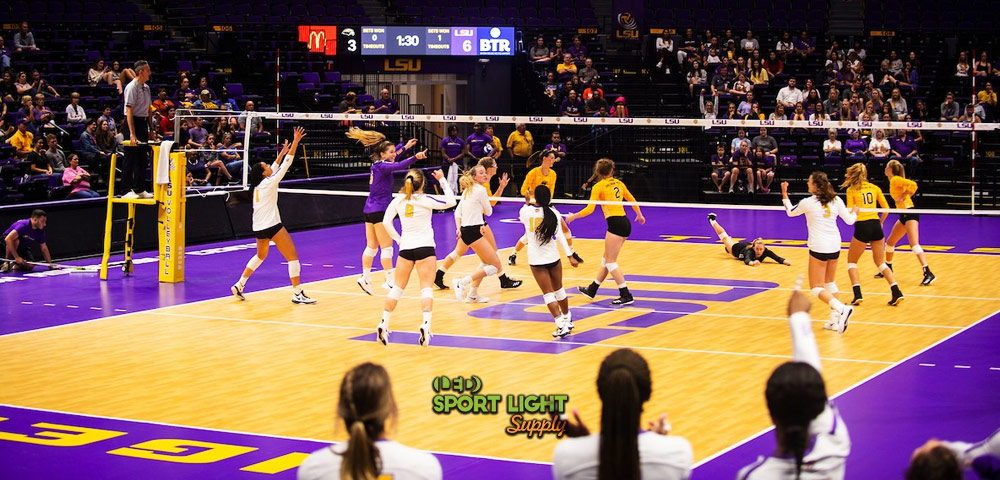
The lighting designer must provide evenly spread illumination in every part of the pitch. Typically, a lighting uniformity value between 0.5 and 0.7 is necessary to pass the related lighting requirement.
In brief, lighting uniformity is the ratio between two particular lux readings. First, you divide the volleyball court into a grid. The goal is sampling each square to get a lux value. Finally, you divide the smallest value you found by the higher one. That is how you calculate lighting uniformity.
3. Sea-waterproof lighting for a beach volleyball court
Most outdoor sand volleyball courts have the sea in the background. So, the flood light casings must be waterproof. Mostly to deal with the recurrent showers of rain and storm surges.
Big spills are frequent near the shores. So, waterproof protection IP65 to IP68 is prevalent for beach volley lights. Of course, IP68 lights perform better and last longer.
The difference between different IP rated lights resides in the International Protection protocol. The second digit refers to liquid ingress protection. To specify, zero represent non-existent protection. Instead, nine means highly resistant to hot, pressurized water for long periods of time.
4. Dust-proof
At any time, sand might enter and damage the lamp body. So, dust-proof and dust-resistant cases are needed.
In this case, the same IP code that regulates waterproofing applies. The first digit of the IP rating refers to solid particle protection. In detail, the first number related to bigger particles. That is, bigger than 2 inches. Instead, number six refers to dust-tight cases. This is the reason why mounting IP65-68 LED products is imperative for outdoor volleyball court lighting systems.
5. Flicker-free
LED tech evolution has changed the lighting product market. But at the same time, it set the standard for high-end lighting products. Issues like flickering became relevant for cameras. In detail, broadcasters need flicker-free lights to stream the live event or to record a beach volley match.
Flickering and strobing affect the perception of light. In reality, these two phenomena were already known with traditional sources. But they were measured and evaluated only in particular situations. Today’s broadcasting quality has remarkably improved. So, volleyball facilities need to install flicker-free lights to get the best results.
6. Glare-free
Innovative anti-glare micro-structured lenses and optics do not reduce the luminous flux but significantly reduce glare. In this way, the volleyball setters/blockers will not feel dazzled when serving, passing, or jumping.
The first official benefits from glare-free LED lights as well. In fact, calling a double is hard for a ref. And lights with high glare ratings can momentarily impair the first official’s vision, who is unlikely to spot a ball without spin. On the other hand, the ref could be tricked into calling a double because of the brief glimmer.
7. 2-pole or 4-pole layout
Positioning the LED light fixtures and poles has the biggest impact on the sand volleyball court lighting. So, over time, two standard layouts became wide-spread. They are:
- 2-pole layout, with 1 pole at the center of each sideline
- 4-pole layout, with 2 poles per sideline
The main goal of the pole layout is to find the most efficient angles to illuminate the court. Sometimes, sand layers or other obstacles might hinder the installation of a light pole foundation in a specific spot. So, outdoor custom layouts are possible as well.
The 4-pole layout can eliminate the shadow as the light is coming from four directions. So, it is preferable in any high-level competition.
Indoor sand volleyball court lighting design and layout
1. Direct or indirect lighting
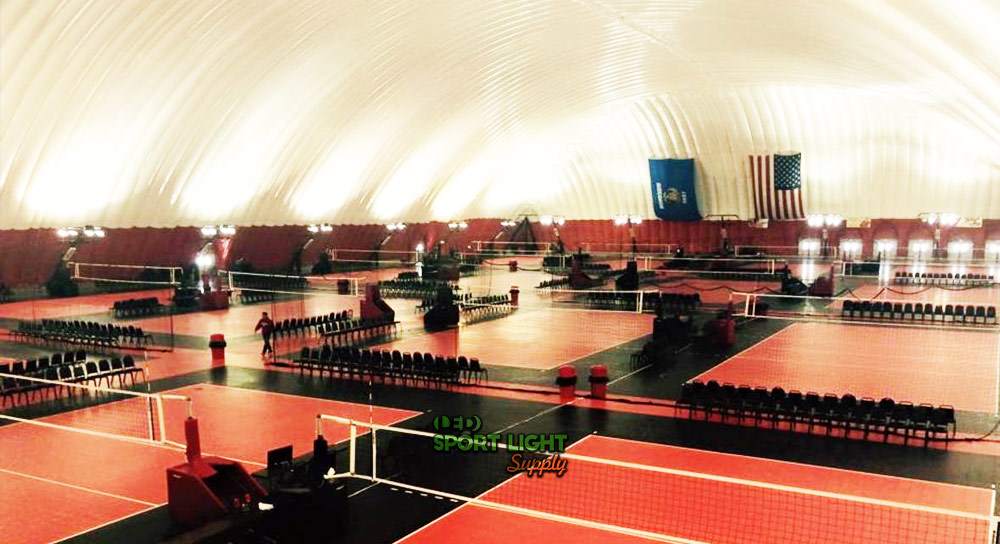
Indirect lighting offers higher lighting uniformity, but it is more power-consuming. Often, the pursue of cost-efficiency and convenience scares indoor volleyball court owners away. However, sports arenas with indirect lighting make for great first impressions.
Direct lighting uses lights pointing downward. Instead, indirect lighting uses reflected light. The perfect balance between indirect and direct lighting enhances the indoor space. Plus, this mix makes the venue more beautiful and also more comfortable.
2. Spacing between the high bay flood lights
Sports lights must be distant 2 to 4 meters from each other. Mainly depending on the ceiling height and beam angle of the lights.
Each manufacturer details the product features to include one or more beam angles. Some LED models may come with shielding or accessories to further regulate the luminous flux. But on average, high bay lights are available with a wide beam angle (120 degrees) or a narrow one (50 degrees).
3. Ceiling height
No indoor volleyball match should take place inside a facility lower than 20 feet (6 meters). Otherwise, after the ref gives the authorization to serve by moving the hand to point the serving direction, an underhand serve could send the ball bouncing straight off the roof.
Expert beach volley players could probably pull it off. Especially by exchanging jumbos and pokeys. But the average player would not enjoy a low ceiling.
Benefits of replacing metal halide, halogen or mercury vapor sand volleyball court lights with LED
1. LEDs are brighter and more energy-saving
Traditional light sources have always been troublesome for anyone installing beach volley lighting systems. After all, metal halide, halogen, and mercury vapor lamps get really hot.
You need to calculate an appropriate installation height just to avoid proximity burns. But LED lights changed that. Not only do the diodes emit more bright light at a lower working temperature, but they also consume less power.
2. Long-lasting products
LED-based light bodies have a superior life span. In detail, a chip provides the constant voltage input and guarantees the long life of the LEDs.
Most LED sand volleyball court lights last for more than 100,000 hours without faults. Instead, halogen bulbs can break down even before the 6,000-hour mark. In fact, overheating leads the traditional light sources to a short life cycle.
Mercury vapor lamps might work up to 25,000 hours. But they also contain a dangerous compound. Plus, they present another hazard: exposure to ultraviolet radiation. Just like metal halide lights. On the other hand, LED lights are a safe option all along.
3. Saving maintenance costs
At the early signs of overwattage or overcurrent operation, you might need to replace HID bulbs such as metal halide and mercury vapor lamps. Moreover, the capacitor can break. Or you might need to correct the supply voltage. In short, traditional light sources need periodic and extraordinary maintenance.
LED lights have a simpler design. They rarely die unexpectedly. Plus, diodes do not suffer from overheating and other issues that lead to maintenance routines.
4. Color-changing function
One of the perks that are uniquely linked to LED lights is their ability to change color. This feature applies to both multi-color (RGB) and standard white lights. In effect, you can change the color of RGB lights thanks to dedicated software. But at the same time, you can set a varying color temperature to simulate different times of the day.
Most LED lights have a standard color temperature of 5,500 K to mimic daylight. However, you can set a more bluish or yellowish hue to meet the players’ preferences.
5. Versatile lighting control
LED supports DMX/DALI. This means that you can easily group or address the lights individually. So, switching on/off the lights in different sand volleyball courts become more convenient. Besides, a timing function is also supported to further increase the ease of operation.
Thanks to this versatile lighting control system, the lighting design will include simpler cable management. This also means less copper running under the sand nearby the beach volley event and spectators.
What determines the cost of sand volleyball court lighting?
1. Lux level required (level of competition)
The higher the lighting requirement, the more expensive the lights. On average, the lighting cost range for recreational purposes varies between $300 and $800 per sand volleyball court. So, if you plan to host tournaments, you are better off taking into account all the possible variables. That is, the following factors.
2. Size of beach volleyball facility
The running cost is directly proportional to the size of the sports facility. With this in mind, indoor or outdoor facilities with a multi-sports pitch should consider the installation of a lighting control system to swiftly change the lighting profile.
3. Height of sand volleyball court light pole
Higher poles increase light loss. So, you need more lights.
Experts like us use professional software to calculate the light loss factor of each pole layout. In detail, we measure the decrease in light intensity from the light source. Then, we add more light fixtures and luminaries to counteract the light loss. This is how we ensure the desired lux level.
4. Light source
LED is more expensive than HID/mercury vapor lamps. However, LED lights last longer. So, it is a worthwhile investment that pays off over time.
On the other hand, traditional lamps are cheaper to buy. They are also energy hogs, and they still need periodic maintenance.
All in all, LED lights are a savvy asset for smart investors. You get a functional lighting system for your outdoor and indoor sand volleyball court that works anytime you want. Plus, it withstands time and bad weather better than any other alternative to host other events and social beach volleyball games. In a way, LEDs are key components of every business plan template.

